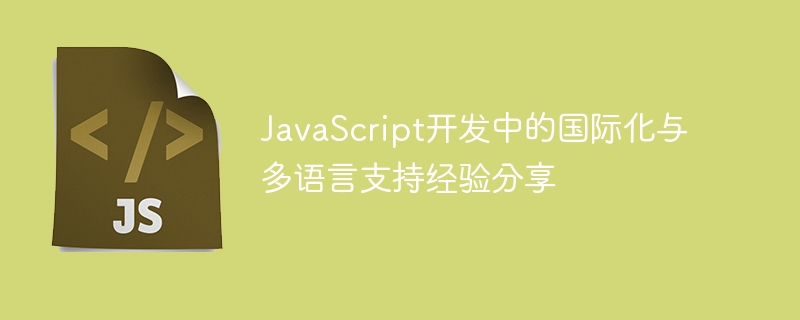
In today's era of globalization, software development is no longer limited to specific regions and languages. More and more companies and developers are beginning to pay attention to the issues of internationalization and multi-language support. In JavaScript development, how to effectively implement internationalization and multi-language support has become an important issue. This article will share some experiences about internationalization and multi-language support in JavaScript development.
1. The significance and importance of internationalization
Internationalization refers to taking into account the adaptability to multiple cultural backgrounds and language environments during the design and development process of a software product or website. Ability. In the context of globalization, internationalization can not only make software products more easily accepted by global users, but also bring wider markets and opportunities to enterprises.
For JavaScript development, the importance of internationalization is self-evident. With the popularity of JavaScript applications, more and more users come from different countries and locales. If you do not have the ability to internationalize, it can easily lead to poor user experience, or even the inability to promote and use it globally.
2. Implementation methods of multi-language support
In JavaScript development, there are many ways to implement multi-language support. The following are some of the common ways:
- Use the traditional string replacement method:
This method is the simplest and most intuitive way, by replacing the text string that needs to be translated with the corresponding Translate text. However, this method is not flexible enough. In the case of multi-language support, it is necessary to maintain translation files in multiple languages, and a large number of string replacements are performed in the code, which is difficult to maintain and manage.
- Use language pack:
Language pack is a way to centrally manage translated texts. During the development process, all translated texts are stored in a language package, and multi-language support is achieved by specifying a specific language package. This approach can better solve maintenance and management problems, but requires additional language pack files and corresponding logic implementation.
- Use the internationalization library:
The internationalization library is a tool library that provides internationalization and multi-language support, which can help developers implement multi-language support more efficiently. The library usually provides methods for translating strings, automatically selecting the corresponding translation text based on the current locale.
3. Management of language resources
In JavaScript development, the management of language resources is also a key issue. The following are some suggestions:
- Use a unified language resource file:
In order to facilitate management and maintenance, it is recommended to store all language resources in a unified resource file. Each translated text can be located by a unique identifier.
- Use an appropriate file format:
You can choose an appropriate file format to store language resources, such as JSON, XML, etc. This makes parsing and reading easier, and can be expanded as needed.
- Provide a friendly translation tool:
For multi-language support, it is important to provide a friendly translation tool. This makes it easier for translators to perform translation and management, and reduces the possibility of manual errors.
4. Language switching and automatic identification
In JavaScript development, language switching and automatic identification are also important functions. Here are some suggestions:
- Provide the option of language switching:
The application should provide the option of language switching so that users can choose the appropriate language according to their needs. The language switching interface can be provided through drop-down menus, buttons, etc.
- Automatically identify the user's locale:
In situations where manual language selection is not possible, the application can automatically switch languages by automatically identifying the user's locale. The user's locale can be identified through the browser's language setting or IP address.
5. Testing and debugging
Finally, for applications with multi-language support, testing and debugging during the development process are also essential. Here are some suggestions:
- Write comprehensive test cases:
During the development process, you should write comprehensive test cases that cover multiple language environments and different translated text scenarios. This ensures that multi-language support functions correctly and reliably.
- Design an international friendly error handling mechanism:
In the event of an error, the application should be able to handle the error in a friendly manner and give the user corresponding prompts or solutions.
Summary:
In JavaScript development, it is very important to achieve internationalization and multi-language support. Through appropriate methods and methods, multi-language support can be effectively achieved to enhance user experience and product competitiveness. At the same time, during the development process, attention should be paid to issues such as language resource management, language switching and automatic identification, testing and debugging, to ensure the quality and stability of multi-language support.
The above is the detailed content of Sharing experience on internationalization and multi-language support in JavaScript development. For more information, please follow other related articles on the PHP Chinese website!






